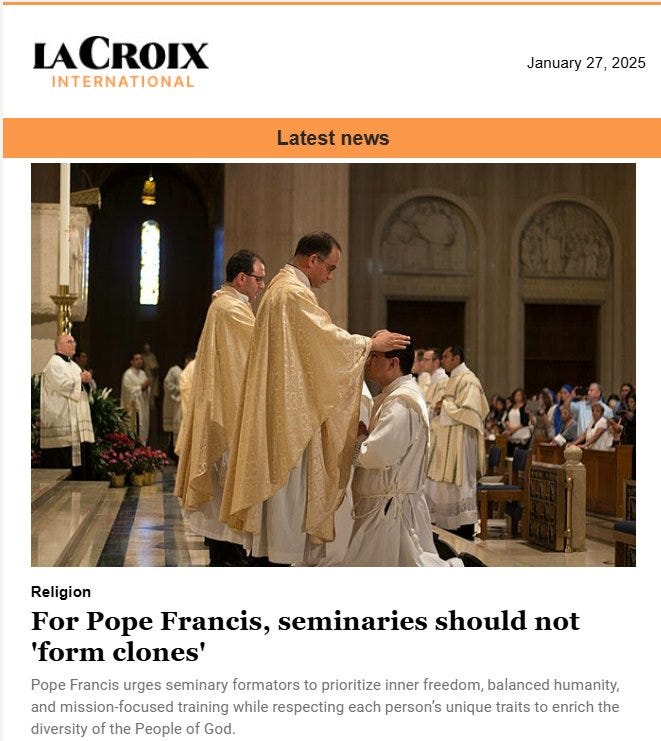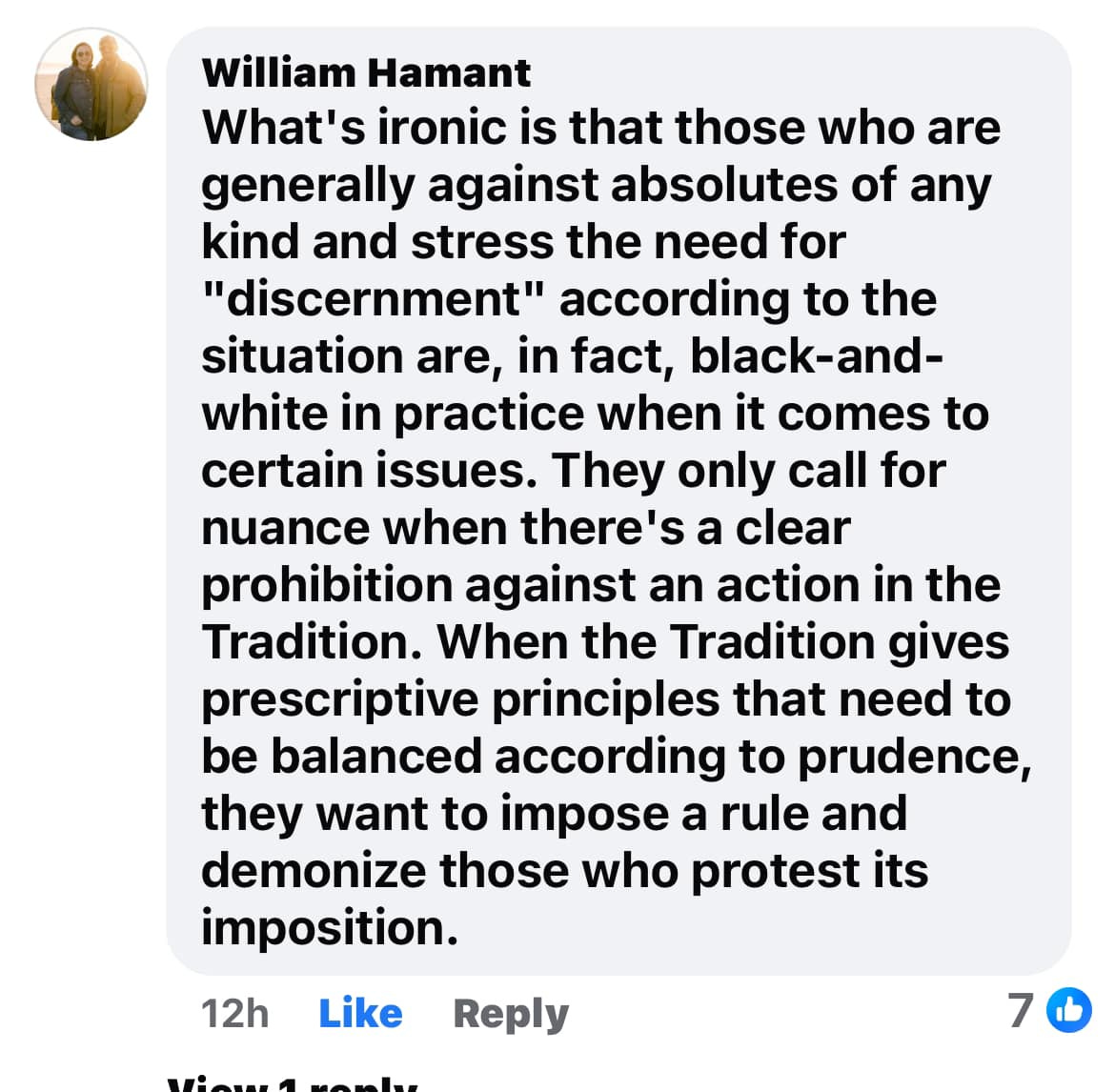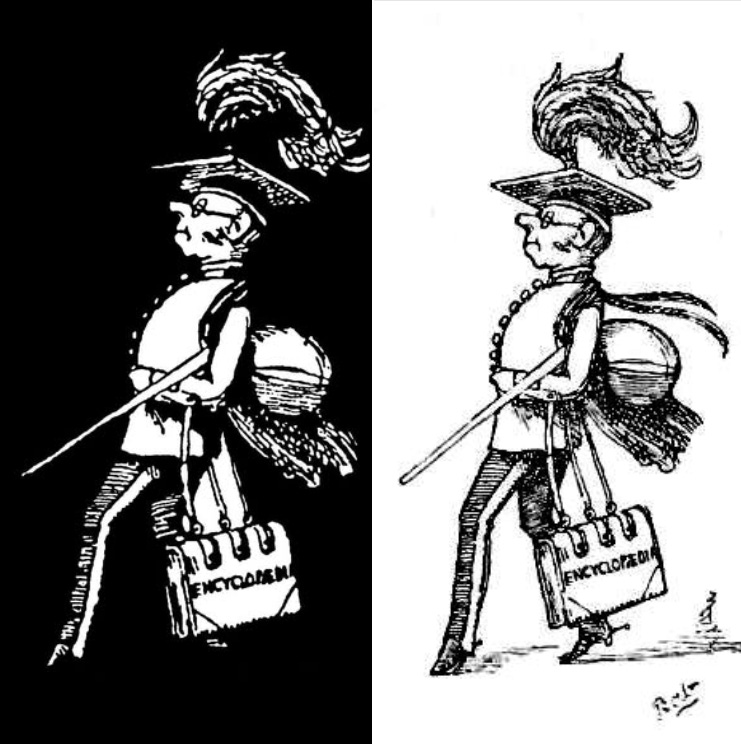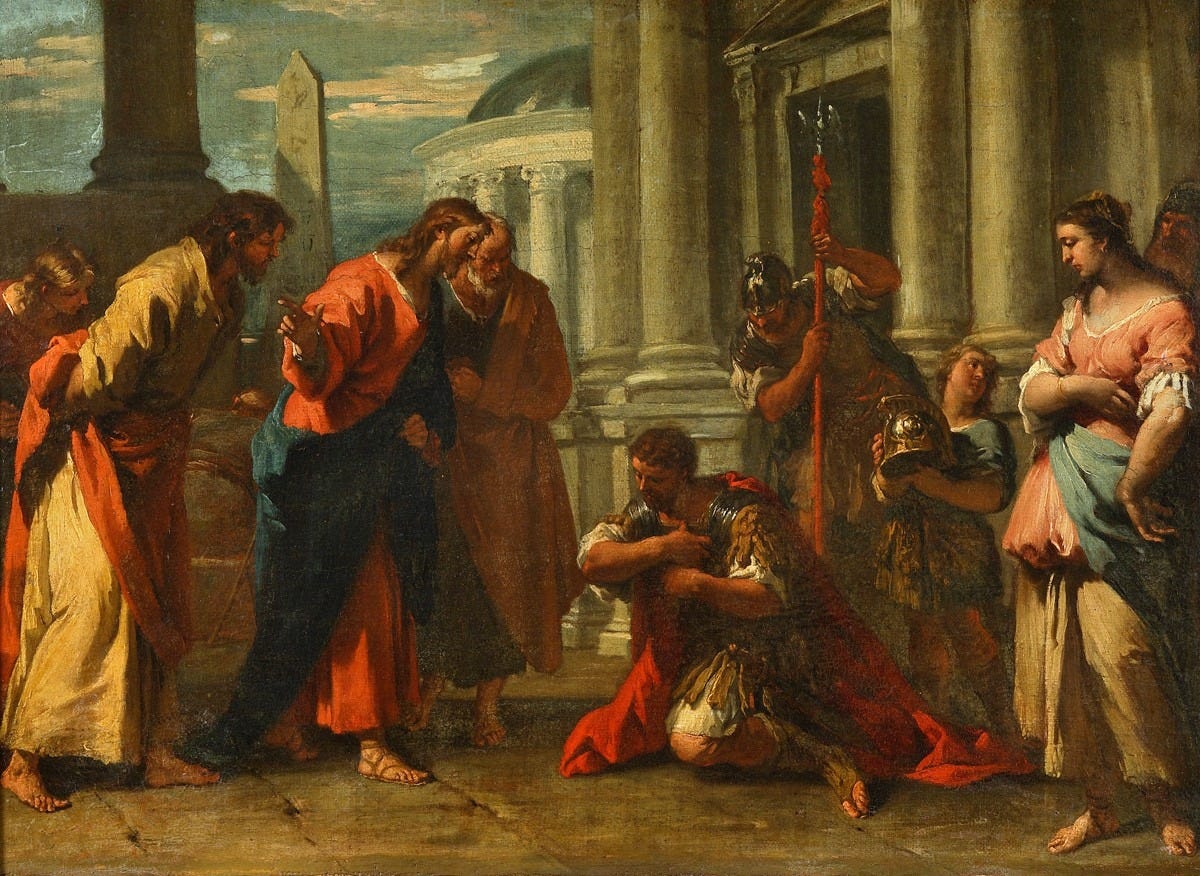Preliminary Note
Starting next week, I will be on pilgrimage in Sicily for two weeks, following (partly) in the footsteps of John Henry Newman, visiting the relics of many saints, and immersing myself in Baroque and Norman-Arab architecture with fellow pilgrims.
Accordingly, the standard Weekly Roundup will resume on February 21; nevertheless, I have prepared book-related special features for February 7 and 14, so keep an eye out for those!
Reminder of our Special Offer . . . until February 3, get 25% off on a year-long subscription to Tradition & Sanity:
Call for Prayer
The Priestly Fraternity of St. Peter has asked clergy and laity to join them in a novena from February 2 to 10. The Communiqué from the Fribourg HQ reads as follows:
Three years ago, at a moment of deep incertitude, the Priestly Fraternity of St. Peter called out to the Immaculate Heart of Mary, mindful that never was it known that anyone who fled to her protection has been left unaided. Following a novena, the Fraternity consecrated itself to her Immaculate Heart on the very day that the Holy Father providentially published the decree reaffirming the practice and charism that the Fraternity has had from its foundation.
Three years later, in order to render thanks once again and implore her continual help, all the members of the Fraternity will solemnly renew this consecration. To represent them all, the members of the Plenary Council and I will recite the act of consecration at the Grotto of Lourdes on her feast day, February 11.
We ask all the faithful who are close to us to join in this novena of preparation February 2-10, 2025 and to renew the consecration on the Feast of Our Lady of Lourdes, February 11, 2025.
Fribourg, January 18, 2025
Rev. John Berg
Superior General
The recommended prayers may be found here.
Good News
Mr. President
Donald Trump continues his right-wing rampage as he shuts down liberal and progressive programs left and right, puts better people in key positions, fires opponents, and in general acts more like a monarch than a president. As someone said online: “If this is what tyranny looks like, I’ll take a double helping.” I know he’s not perfect, far from it. But I believe my vote was cast well, for the reasons I gave the day before the election in November.
Right around the time of Trump’s inauguration, the big government website set up by the “Catholic” (now Freemason) Biden in 2022 to promote contraception and abortion was simply pulled down. Gone, just like that.
In addition:
Trump’s executive order entitled “Defending Women from Gender Ideology Extremism and Restoring Biological Truth to the Federal Government” must surely be one of the greatest and most necessary presidential acts in history. Whoever wrote it obviously understood his subject well. I said to my son, “It’s as if they’ve got a Thomist somewhere on the president’s staff.” (For excellent commentary on this order, read Regis Martin’s “How Many Genders Have We Got?” and Leila Marie Lawler’s “President Trump’s Excellent Executive Order.”)
On January 28, he signed the executive order “Protecting Children from Chemical or Surgical Mutilation,” in which it is said (inter alia):
It is the policy of the United States that it will not fund, sponsor, promote, assist, or support the so-called "transition" of a child from one sex to another, and it will rigorously enforce all laws that prohibit or limit these destructive and life-altering procedures.
Pray for the president. He’s very imperfect; so indeed were most “Catholic kings” in history. But he can still be, and I believe will be, a major instrument for good.
Meanwhile, J.D. Vance gave a speech at the March for Life in Washington DC that would be difficult to imagine any other politician in the Western world giving at this time. It’s no mealy-mouthed nicey-nice speech, but an uncompromising clarion call for a pro-life nation supported by good family policy and supporting the flourishing of families, without which we are doomed.
And, when Vance said on CBS’s “Face the Nation” that the U.S. Conference of Catholic Bishops has “not been a good partner in common sense immigration enforcement,” I cheered. At last, a bit of the Catholic Secular Arm showing its muscle. We’ve been waiting.
Hope for Germany?
Reports The European Conservative: “Firewall Crumbles: Bundestag Passes Migration Motion With AfD’s Support.” Namely: “The German centre-right and right-wing parties said that introducing tough asylum laws takes priority over the hysterics of the Left.” Deo gratias. Might this be the beginning of a shift in mentality? May there be be a wave of rightward policy everywhere, before it is too late to save anything.
Marylike Dresses
I’m very happy to recommend to your attention a new business: Marylike Dresses. I have often posted about unfortunate trends in women’s fashion and I’m always glad to point to people who are making a positive difference.
Opportunity for Young Adults
REGINA’s “Cabrini Tour” to New York City this Spring, led by Fr John Perricone and Beverly de Soto, will be amazing opportunity for young adults to meet, exchange ideas, visit great sites, deepen their faith, and have an unforgettable experience. The price ($998) includes accommodation, all meals, entrance fees, and transportation in NYC (does not include airfare and airport transfers). Find out more here.
Huge budgets are not necessary for a church remodel
One thing I appreciate about Liturgical Arts Journal is that they feature not only gigantic projects of new construction or renovation but also modest projects that take a rather plain modern church to a much better place, without a multi-million budget. A recent “before-and-after” article furnishes a case in point, from Killeen, Texas.
Other News
Bishop Richard Williamson…
…has died at the age of 84 and returned to his Lord. Requiescat in pace. The reactions, as may be guessed, are diverse and will increase for some time For an admiring sedevacantist’s perspective: “RIP Bishop Richard Williamson.” The usual complaints made against him may be read here.
Clones ‘R’ Us
This headline from La Croix, which I read as a penance, caught my eye:
Where’s the “inner freedom” for seminarians who are forced to stand for communion when they wish to kneel, forced to give up wearing the cassock, forced to forget about learning the TLM? What kind of freedom is that, or respect for diversity? Some of the worst cases of “rigidity” I’ve ever heard have been from Novus Ordo seminarians who complain of being browbeaten by a twisted Jesuitical notion of obedience and propagandized with “Vatican II everything.” Some of the finest men, in fact, are drummed out just this way, and one can’t help but wonder if that is keenly intentional, since real diversity would mean the end of the strange pragmatic alliance between progressivists and conservatives. Homosexuality appears to be less of a problem than it was in decades past, but pressures against the orthodox and traditional are, alas, all too alive and all too well.
Double standards
Along these lines . . .
On which Erick Ybarra gloriously rants:
So when it comes to things that are unmistakably clear from Tradition, such as the necessity of faith in Christ for salvation, moral theology, sexual ethics, the first 3 of the 4 last things (death, judgment, and hell), etc. etc., certain “theologians” want the world to turn into jello to allow for a groovy acid trip through nuance, mitigating factors, situational reductions to culpability, and whatever add-mixture…. But when it comes to things from Tradition that really always have been a matter of less clarity, such as the discretionary application of just principles and natural law (i.e., the issue deportation), the folks who are doing the hula dance while puffing the magic dragon on the former subjects all of a sudden straighten out, strap/uniform up, and turn into high-precision Navy Seals with accompanying snipers and stealth bombers with their inflexibly black-and-white condemnation of the conservatives when the latter explore nuance.
As Gregory DiPippo likes to say, if some people didn’t have double standards, they’d have no standards at all.
Relatedly: in “Angelic Sins and the New Orthodoxy,” Dr. Tomasz Dekert, a professor of religion in Poland, explains how Francis utilizes a classic technique to attempt to neutralize all opposition.
Senior Sisterhood
Pope Francis met with aged, plainclothes sisters in Rome recently, from a dying order — and his main advice? Don’t gossip. Not: return with fidelity to your foundress's principles and way of life; recommit yourselves to the radicalness of consecrated life; take up the traditions that once filled the convents. No. He and they all belong to the same generation, which has no successors.
A Gilbert & Sullivan interlude
Sent to me by a reader.
I am the very model of a modern Francis popesplainer,
His teachings are official and could really never be plainer,
His every private utterance, his personal embellishment,
Is but the application of our Doctrinal Development;
Thanks to the Holy Father and his charismatic eloquence
Tradition that’s a bother is abolished as irrelevance.
We used to be imprisoned by outdated clear morality
But now we make decisions though synods on synodality.With plans so visionary and with past’ral ingenuity
We need no missionaries nor dogmatic continuity
Whoever disagrees with me is just a rigid complainer,
I am the very model of a modern Francis popesplainer.I am the very model of a modern Francis popesplainer,
I’ll help you swallow camels; it’s a sin to be a gnat-strainer.
My mental acrobatics are not understood with clarity
Because of these schismatics and their utter lack of charity.
The trads are overreaching in their backwardist delirium
To think that prior teaching’s still part of the magisterium!
They’d be in a position to know who our Fearless Leader is
If only they would listen to the blog that’s called “Where Peter Is.”Give blessings to the gay and to the global-warming cabalist?
Abortion politicians can still queue up for the Eucharist?
If pontifex okays it then it must be just a no-brainer:
I am the very model of a modern Francis popesplainer.
Intelligent life at the Vatican
The Dicastery for the Doctrine of the Faith and the Dicastery for Culture and Education together released a 117-paragraph reflection on January 28 called Antiqua et Nova: Note on the Relationship Between Artificial Intelligence and Human Intelligence. I haven’t had a chance to read it yet, but I welcome this kind of reflection on a topic of immense, burgeoning, and disturbing actuality. Would be curious to hear any reader’s thoughts about it. The Pillar, never one to let a good story pass by, decided to ask Grok, ChatGPT, and Gemini about the document. You can read their responses (plus what appears to be real human journalism) over there.
Liturgical Lessons
Pitre vanquished
Gregory DiPippo has concluded his pulverizing critique of Brant Pitre this past week with a Part 4 and a Part 5. I cannot recommend too highly the whole series (you’ll find all the links at the start of Part 5), as it shows just how many errors even reputable scholars can commit when they step into the area of liturgical history and theology. Indeed, even professional liturgists nowadays often lazily repeat past “certainties” without recognizing how many of them have been overturned. It requires a considerable multilingual and multidisciplinary expertise, with attention to a staggering number of details. DiPippo has these qualities, and, sadly, Dr. Pitre does not. In his final installment, DiPippo mordantly comments:
Having substantially and systematically mispresented the history of the liturgy, and of the laity’s participation in it, for almost 38 minutes, the remainder of his presentation is devoted to extolling the virtues of the post-Conciliar reform specifically vis-à-vis active participation.... Active participation was not created in the ancient world by non-existent directives in liturgical books, it was not ended by their supposed disappearance, and it has not been restored by their putative return.
“Save the parish” or save your souls?
I returned to Crisis Magazine last week with a piece that’s been very popular: “Sometimes We Should Not Try to ‘Fix’ the Local Parish.” Here’s how it starts:
Auguste Meyrat’s article “How to Save the Music at Mass” rightly sounds a clarion call for restoring better music at Mass through taking the entire question of music seriously to begin with (which includes paying at least some of the musicians what their knowledge, training, and ability justly deserve). As one who has been singing in and directing choirs for decades, I can only say, “Hear, hear!”
I take issue, however, with a significant component of Meyrat’s argument. He noted that he once attended the traditional Latin Mass and reveled in the “exquisite music [that] lifted the souls in the congregation.” Yet, he later judged it better to go back to his local parish, to the “Mass of the Boomers” with “frequently cheesy” music, because “there’s something to be said about going to Mass with one’s actual neighbors.” And, with a lot of work, one might eventually achieve “suitable music at Mass.”
In a spirit of fraternal conversation, I’d like to suggest that this path may, in fact, be not only difficult but dangerous and that families should think twice before pursuing it.
An essay that sums up the traditionalist case
Fr. Perricone sees the difference between the old shell and the plague of novelties at Notre Dame as typifying our times: “Why the Walls of Notre-Dame de Paris Are Groaning.” A taste:
It is in this field of combat [symbol, art, architecture, ritual] where hearts and minds are won. The theological grandees understood this well. After their tomes were carefully written, they well grasped that what would win hearts and minds was their iconoclasm. Sacrosanct rules that guided the architecture of churches for millennia were overturned with a rage verging on the fanatical. Sacred vestments, always resembling the canvasses of Rubens and van Eyck, were systematically gathered and destroyed. Sanctuaries that once evoked pages of the Book of the Apocalypse were leveled. Sacred vessels, always meticulously crafted with gold and jewels bespeaking awe of the sacred wealth which they contained, were cast aside with a malign devotion bordering on the maniacal.
All the while, Catholics were reassured that this liturgical carnage was the wish of the Church’s new conciliar spirit of “simplicity.” It was not. In typical fashion, this was the Modernist’s favored term to palliate the unwashed masses. With brutal consistency, the effects of lex orandi, lex credendi set in. Doctrines such as the Real Presence, the Mass as sacrifice, the reality of sin, the cult of the saints and angels, and the very notion of piety and devotion were blurred, if not swept away like flotsam in a tidal wave.
Lion of the C.I.P.
After a long interval, Jerome Striden resumes his 1P5 series on the Coetus Internationalis Patrum of Vatican II, the group of (depending on how you count it) 900 or so bishops and periti in league with one another, working against the progressive tendencies at the Council. Its main leader and animating spirit was Marcel Lefebvre. Regardless of what you think of his later actions, this much is beyond doubt: the documents would have been worse without the work of the C.I.P., who drove home objections and demanded certain rewrites. In “Lefebvre on the Eve of the Council,” Stridon takes a look at the “vota” that Lefebvre submitted prior to the Council, when John XXIII asked every future participant to say what he wanted the Council to take up. There are some surprises.
Chalice of salvation
Dr Michael Foley continues his series on the Ordinary of the Mass at NLM, with a contribution on the “Offerimus tibi” (offering of the chalice). To follow this series is to appreciate, all over again, the perfection to which the Roman Rite attained, and why we must retain it and restore it everywhere.
The Lord’s right hand
Speaking of perfection, here’s the kind of thing you get in a liturgy that has been quietly growing for a thousand years, like that gospel mustard seed. Look at the wonderful interplay on the 3rd Sunday after Epiphany (that is, this past Sunday) between the Collect, the Gospel, the Offertory, and the Communion.
COLLECT. Almighty and eternal God, mercifully look upon our infirmity, and stretch forth the right hand of Thy majesty to help and defend us. Through our Lord...
GOSPEL. At that time, when Jesus was come down from the mountain, great multitudes followed Him: and behold a leper came and adored Him saying: Lord, if Thou wilt, Thou canst make me clean. And Jesus, stretching forth His hand touched him, saying: I will. Be thou made clean. And forthwith his leprosy was cleansed... [then follows the famous episode of the Roman Centurion, “Lord, I am not worthy that thou shouldst enter under my roof,” etc.] And Jesus hearing this [faith of the Centurion] marvelled . . .
OFFERTORY. The right hand of the Lord hath wrought strength: the right hand of the Lord hath exalted me: I shall not die, but live, and shall declare the works of the Lord.
COMMUNION. All marveled at these things which proceeded from the mouth of God.
In the Collect, we pray that God will stretch forth His right hand to help and defend us. The Offertory echoes that by saying the Lord’s rigth hand hath wrought strength and exalted me, leading me from death to life, and to the proclamation of God's great works. In the Gospel we then see the Lord stretch forth His right hand to touch the leper and heal him from a deadly disease—and then see Him use the mere power of His word to heal the servant of the Centurion, at whose faith he marvels (and whose faith we imitate by repeating the Centurion’s words three times before receiving Communion). Finally, in the Communion, we ourselves marvel in return at what proceeds from the mouth of the Father: His Son—“the almighty Word that leapt down from [God’s] royal throne” (cf. Wis 18:15)—and marvel at the Son’s healing command, His word of life.
Holy Days of Non-obligation
Remember all that business about the Holy Day obligation being transferred from December 8 to December 9, and all the confusion and hand-wringing that went along with it (sometimes, I might add, for good reason)? Well, Cardinal Roche has just dropped a bomb on the whole USCCB approach, which was based on the advice of another Vatican dicastery. Goodness, nothing like warring departments. No wonder DiPippo calls them “disasteries.” The longer I live, the less it seems to me worthwhile, or even defensible, to take one’s marching orders from the clowns who run the circus. Take your marching orders from absolutely reliable tradition.
Guide to the pre-55 Holy Week
Speaking of which… It’s time to think about getting what you need for celebrating the pre-55 Holy Week. Dom Alcuin Reid’s monastery has got the priests, MCs, and sacristans covered. For more on how to order this volume, visit this site. (If you don’t use PayPal, you can send payment by any method given at the website and then simply send an email to specify that your donation was for the book: contact@monasterebrignoles.org.)
A follow-up on Confession
Partly prompted by my Substack piece on Confession, Leila Marie Lawler brings out many further aspects of the problem in her post “The Novus Ordo Rite of Penance finds us awkwardly uncertain.” Excerpt:
The main takeaway from the changes brought on by Pope Paul VI’s meddling [with the sacrament of confession], is, as I say, an insistence on the absence of form. In the Novus Ordo established by Pope Paul VI, and this is my point, no one really knows how it should go and Fr. Cole does nothing to clear the problem up. The absence of form results in an absence of meaning. The faithful don’t really go to the sacrament much, for many reasons, some of them having to do with seldom if ever hearing about repentance or the necessity of salvation for eternal happiness, and, in part, because it’s often not available; in short, because it is treated as having low meaning.
If you read her piece, you’ll see why she’s saying this.
Skipping Scripture: how naughty!
It’s very hard not to see patterns when you start looking for them. A friend sent me a list of the NOM readings for Sunday, January 12:
Note what’s left out.
First reading: Isaiah 40: 1-5, 9-11 (skipping “but the word of our God shall last forever”)
Second reading: Titus 2: 11-14, 3: 1-7 (skipping 2:15 which says “rebuke with all authority”)
Gospel: Luke 3: 15-16, 21-22 (skipping the Lord’s warnings about Hell).
Female lectors and acolytes?
Tradition speaks a hard and clear no. Read why here.
Tired of novel ideas?
So is JohnMark Cayer. And his observations point to one of many reasons why liturgy needs to be absolutely stable, predictable, even, dare I say, “petrified” or “ossified.” You know, like a solid rock on which one can confidently build. I seem to recall Our Lord saying something about what happens when people build a house on shifting sand. It didn’t end well.
The interior core of Christian life
The sacred liturgy and the prayer of the heart are meant to go hand-in-hand. David Torkington is right to say that the condemnation of quietism left the latter part stranded and then abandoned over time, with externalism and activism as a temptation, which finally yielded to worldliness. This is his basic account of what went wrong in modern times — including before and after Vatican II.
Morality and aesthetics
Over at NLM, Alan Hicks’s essay “On Music and the Beautiful” — on the objectivity of the beautiful and the manner in which habituation in what is beautiful shapes the human character — presents us with a key truth to bear in mind when considering the beauty of the liturgy in its ceremonies, music, vestments, furnishings, and architectural setting: not only is giving glory to God by the best we can offer at stake, but also the formation of Christians in right instincts, appetites, and responses. The moral and the aesthetic touch at every border. It is also clear that true beauty takes time to get used to, and that we do no service to anyone by making “instant relevance” or “easy accessibility” the sole or primary criterion.
Other Articles Worth Reading
Robert Lazu Kmita, “Rock and Pope. Saint Augustine’s Last Thought”:
How can we remain unshaken when we witness the apostle Peter, who lived and evangelized alongside Jesus Christ Himself, and who, after being a witness to God, becomes an instrument of the devil? Why are both episodes—Peter, the “rock,” and Peter, under the influence of Satan—placed in the same chapter of the Gospel according to Matthew? Don’t you think that there is a message intended for us, who find ourselves today in the greatest crisis in the entire history of the Church?
I believe it would be an excellent meditation for any of us to meditate again on the entire 16th chapter of the Gospel according to Matthew, praying to God to enlighten us and help us fully understand its meanings. And if we add to this Peter’s three acts of denial of Jesus and his subsequent repentance, I think that the picture will be complete.
In a somewhat critical review of Dreher’s latest book, Stuart Chessman makes an important observation:
Dreher has moved in this book beyond the facile optimism of The Benedict Option and the focus on cultural and political catastrophe of Live Not by Lies. He correctly sees that what is needed is the recovery of faith and of spirituality. Disenchantment is a defining feature of contemporary Western culture. A culture, however, cannot be changed by the exercise of the willpower of individuals or communities however well intentioned. And certainly not by the idiosyncratic spiritual quests of some of the characters quoted in this book. Only generations and even centuries of men living an ordered, sacramental faith can effect a reversal of the present malaise. This world does need to be reenchanted — but that is not something that we should consciously set out to achieve. If and when the perception of enchantment revives it will be the result of the practice of a rediscovered faith.
The great German priest-theologian Vigilius strikes again, this time with a profound essay on the theological foundations of priestly celibacy and the reasons for the attacks on it in modern times. While I imagine everyone has read something about this, I think it's fair to say you will find new insights here.
“Who was the first Holy Roman Emperor? There is a fair amount of confusion surrounding the question of who actually holds the title. Was it Charlemagne or Otto I?” Let Aaron Pattee clear up your doubts.
Robert Lazu Kmita offers a crystal-clear exposition of the meaning of 666 in Scripture, with the help of St. Bonaventure and St. Augustine.
The three-part series on Cardinal Pell at Rorate Caeli is now complete. What an astonishing story. Part 1 | Part 2 | Part 3
Fr. Jason Charron has released a thoughtful, charitable, and dead-on-target video critiquing “Loftonism” (named after YouTube internet personality Michael Lofton), which he describes as a movement of popular entertainment, a conflict generator, and a form of “ironic self-parody” characterized by “buffoonery and hubris.” My favorite quotation: “The unique quality of Loftonism is the total obliviousness of its protagonist and his own acolytes to the self-parody unfolding before them.”
And, hands down, my absolute favorite article of the past week: Angela Lill’s “Women Don’t Need More Ministerial Roles—We Need Churching!” The synodal Church is forgetting one of the most basic and important srole of all, that of being a mother — which is why we used to speak of “Holy Mother Church.”
Thank you for reading, and may God bless you!
Don’t forget to take advantage of the Candlemas Special Offer:



















Happy to join the FSSP in their Novena & Consecration. Question: Is the Vatican done with their "visits" to their Seminaries, etc. I've reached out to the FSSP Church I attend when in FL, but haven't heard back yet. PRAY
The link to Kmita's 666 article is broken, and a search of Kmita's Library itself yields no results. Can anyone please help me track it down? Many thanks in advance.